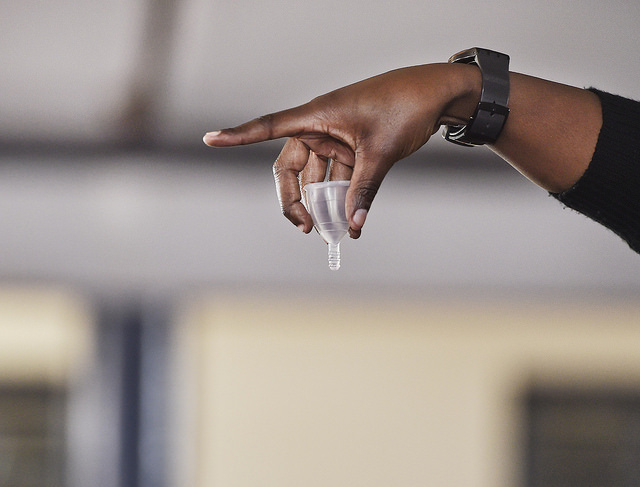As excited as I am about reducing my carbon footprint and not adding to landfills with tampons and sanitary towels, I admit that using a menstrual cup does come with certain challenges.
If there are pros to something, there are always cons too, but these menstrual cup hacks should make life with a cup easier.
If the sight of blood grosses you out, this may not be for you. The cup is not for the faint of heart. You have to get up, close, and personal with your body parts and your blood when you insert or empty the cup. But don’t let that freak you out. Remember, there really is nothing gross about your period!
To make the transition a bit easier, here are six menstrual cup hacks you should know:
1. Cleaning the cup at home.
Since your home is a more familiar place, cleaning your cup there is easier. Every time you empty it, wash it thoroughly with cold water first and then some warm water. If you do not have cup wipes, use a mild and, preferably, a soap and fragrance-free cleaner to thoroughly wash and clean the cup. Reinsert after washing and cleaning.
Top tip: Have at least two cups so that you can alternate between them if needed.
2. Cleaning in public places.
This is a bit tricky. Most places may not be equipped with clean water and cleaning yourself and the cup can be scary. This happened to me twice and I did the following each time.
>> I was in the middle of a transit, waiting to catch a flight back home, when I knew I had to empty the cup. Since I am a bit wary about the water in some public bathrooms, I picked up a bottle of mineral water, emptied the cup, and washed it thoroughly with the bottle of water. After that I cleaned it with the cup wipes that I was carrying with me before I inserted it again.
>> I did not have access to clean water, so I had to use the water in the public restroom. After cleaning the cup with the water available in the bathroom and wiping it with the cup wipes, I put it in a zip-lock bag and stored it to clean when I reached home. I then used the spare cup that I always carry with me.
Top tip: If you are unsure of your access to clean water when you are outside, it is always best to carry your own bottle of water. And stock up on chemical-free wet wipes to clean the cup.
3. Making your own cleaning solutions.
Run out of cleaning agent? Try this!
>> A quick DIY cleaning option at home if you have run out of wipes and cleaning solutions: Mix one teaspoon of vinegar with nine teaspoons of water. Mix thoroughly and rinse your cup out with this homemade solution.
>> Mix some baking soda with water and use a brush to clean the cup.
Top tip: Always look up the cleaning instructions mentioned in the manual before you experiment with DIY cleaners for your cup.
4. Restoring your cup’s original colour.
Menstrual cups come in various colours and, after regular use, it is normal to notice discoloration or stains on the cup. All you need to do after you have cleaned it thoroughly is place the cup in natural sunlight for a few days to restore it back to its original colour.
5. Storing it.
Store it right: Use a breathable, preferably cotton, pouch that will air it continuously till you use it the next time. If you store your cups in zip-locks, plastic pouches, or airtight containers, the material of the cup can be compromised and you’ll notice some not-too pleasant odors emanating from it. Most cups come in cotton drawstring bags for storage. Always keep the cup in a cool, dry place.
6. Other simple care techniques.
>> Do not wear the cup for more than eight hours at a stretch, even if your periods are scant. Empty, rinse, wash, and reuse every eight hours. Ideally, you should clean your menstrual cup every time you empty it. Clean it thoroughly before you insert it again.
>> Sterlize it between periods by boiling it. Sterilizing the cup should, ideally, happen twice a month—once before the cycle and once after the cycle. If you track your periods, you’ll know when it’s time to sterilize.
When boiling the cup, ensure that it stays floating at the top of the vessel the whole time. If it moves to the bottom of the vessel there are chances of the cup melting or burning. Cool the cup and wipe it dry with a paper towel before you store it.
>> Silicone is not a material that harbors bacteria, so it is safe to rinse with water and reinsert. You can use a soap-free mild wash to clean the cup if you want to be extra careful.
>> Use an old toothbrush to clean it thoroughly after every menstrual cycle. Just run the cup under warm water, stretch out the holes, and use the toothbrush to clean it out. Do not use sharp objects to clean the holes as they can damage the cup. Toothbrushes have softer bristles that are gentler on the cup. These four holes are below the rim of the cup and they act like a suction to hold the cup.
~
These awesome menstrual cup care hacks are not complicated at all, even though at a glance it may seem so. I made the switch over three years ago and I enjoy my cup more with every use!
Once you get used to it, you’ll wonder how you ever lived without it. I have lost count of the number of (now) happy women who I convinced to make that switch in the first place.
~
Author: Pratibha Pal
Image: GovernmentZA/Flickr
Editor: Khara-Jade Warren


 Share on bsky
Share on bsky





Read 1 comment and reply